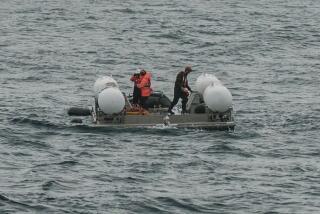Russians Battle Weather, Race Clock to Save Sub
- Share via
MOSCOW — Rescuers attempted a desperate and tricky operation late Tuesday and early today to save the crew of a stricken Russian nuclear submarine trapped at the bottom of the Barents Sea, but poor weather and swirling currents frustrated their efforts.
With time and oxygen running out for the 116-member crew, the operation was complicated by near-zero visibility in the inky seas.
Repeated efforts overnight failed to attach a piloted rescue apparatus above the submarine’s hatch to enable the crew’s evacuation.
A naval spokesman said this morning that it was not clear if the crew was still knocking on the hull to communicate with rescuers. After rescue attempts Monday and early Tuesday were called off because of storms, the rescuers seized their chance during a break in the bad weather late Tuesday. Conditions, however, remained poor at best.
An attempt about 8 p.m. Tuesday to lower a diving bell capable of evacuating up to 20 crew members at a time from the submarine Kursk failed because of turbulent currents.
Russian navy officials reported that the diving bell kept slipping and would not attach to the hull to enable the crew’s evacuation.
The effort was repeated, but met with continued frustration.
After the power on the first diving bell failed, a new diving bell was lowered this morning to renew the effort to save the crew.
With time and weather conditions critical to the success of the rescue, three more days of stormy conditions were predicted.
Analysts said that without power, the temperature inside the submarine--which is lying in Arctic seas at a depth of 354 feet--would be dangerously cold.
Admiral Is Pessimistic
During naval exercises over the weekend, the 13,900-ton, 500-foot-long vessel took on water and plunged to the seabed an estimated 85 miles north of the Russian port of Severomorsk. Power was lost when its two reactors were turned off after the accident.
Russian naval officials said Tuesday that there might have been an explosion in one of the torpedo hatches and reported that several of the vessel’s 10 sections had been flooded.
Without radio contact, there were no details on the number of casualties, if any, on board.
Russia’s naval commander, Adm. Vladimir Kuroyedov, remained pessimistic about whether the crew could be saved.
“The projection of possible consequences of the accident on the Kursk for the lives of its crew remains extremely grave,” he said. “All we know is that the people are alive and sending SOS signals. The only thing else we have is hope, which is running out with every day.”
Norwegian authorities said Russia had handed over a report indicating that the accident occurred Saturday, a day earlier than initially reported. The accident was not made public until Monday.
Russian naval officials initially played down the extent of the crisis, insisting that conditions aboard were not critical. But Tuesday they admitted that, despite earlier assertions to the contrary, efforts to supply fuel and oxygen to the submarine had failed.
The first rescue efforts, carried out late Monday, were called off when a violent storm blew all but two of 15 rescue vessels off their anchors. By late Tuesday, 22 vessels were involved in the rescue.
The designer of the sub, Igor Baranov, said Tuesday that the crew had two more days of oxygen supplies remaining, while naval commander Kuroyedov said the oxygen would run out by Friday.
A sophisticated British minisub capable of evacuating 16 people at a time was on standby along with a rescue team in case Russia requested assistance. The British also offered remote-controlled deep-sea vessels.
United States also offered to help, but there was no indication of whether Russia had formally requested help after the failure of its own rescue efforts.
Throughout Tuesday, the Russians insisted that they needed no outside assistance.
On Tuesday, Navy commander Kuroyedov backed away from his earlier theory that the submarine had collided with an object--most likely a foreign submarine. Russian naval officials suggested instead that an explosion, possibly in a torpedo tube, had flooded part of the vessel’s bow.
Another theory, from Deputy Prime Minister Ilya I. Klebanov, head of a government commission investigating the accident, was that the submarine might have hit a World War II mine. He said pictures of the submarine show “very strange” damage to the craft.
The cover of the missile tube was ripped off, the navigation room was dented, other parts of the submarine were bent and parts of the vessel were scattered on the ocean floor.
Kursk is one of Russia’s largest and most modern submarines, built in 1994 and commissioned in 1995.
With winds buffeting the rescuers and strong currents beneath the surface, the overnight operation to maneuver the diving bell was extremely complex.
The bell apparatus is like an overturned glass piloted by two to three people. It is lowered onto the hull and locks over a hatch, held in place by water pressure. It has to be fixed to a precise position.
Once crew members enter the bell, it is gradually raised. The ascent can take up to seven hours, with frequent pauses necessary to avoid decompression sickness among occupants.
Even if the bell was successfully attached, the rescue of 116 crew members would take at least six trips. Russian officials announced that they had a third diving bell on standby and that two bells would be used if they could successfully attach to the hull.
Fallback Rescue Plan
If the diving bells continue to fail, there is a fallback plan: Kuroyedov said rescuers would lower two 400-ton pontoons on each side of the vessel, sling huge belts underneath it, pump air into the pontoons, raise the submarine to the surface and rescue the crew.
Another last-ditch rescue option is for sailors to don pressure suits and swim up, but they risk serious decompression illness.
“Experienced divers can do it, but we have here a crew with hardly any training, taking into account the financial problems in the Russian navy,” said Igor Kudrik, a naval analyst with the Norwegian environmental group Bellona Foundation. “Of course, they have a chance they might survive” by swimming out, he said.
The submarine is equipped with escape capsules to carry the crew to safety, but they failed to operate after the accident.
With the rescue failure overnight and critical time pressures, the Russian navy is under increasing pressure to take outside help.
Russian officials Tuesday insisted that their own equipment and expertise are equal to the task and cautioned that Western equipment might be incompatible. But British rescue authorities said they were certain the British minisub could dock without problems.
However, Russian authorities approached the North Atlantic Treaty Organization to find out what kind of resources the Western alliance could provide to help rescue the sub, should Russia decide to formally request help, Pentagon officials said Tuesday.
It was not clear, however, what kind of aid the Russians might seek from their longtime adversary or whether senior Russian officials planned to ask for it.
U.S. officials offered help for the second day, but the Russians again politely declined an offer from National Security Advisor Samuel R. “Sandy” Berger and didn’t immediately respond to an offer of help from Defense Secretary William S. Cohen.
The response to Berger “was cordial and appreciative, but they felt that they had enough assets on hand,” said Rear Adm. Craig Quigley, a Pentagon spokesman.
In case the Russians change their mind, he said, the U.S. Navy was checking the readiness of several pieces of rescue equipment. Among them were two Navy Deep Submergence Rescue Vehicles, now at the Navy’s North Island property in San Diego, he said.
But Quigley said the craft might not be useful if the Russian submarine is listing to port at a 60-degree angle, as some Russian reports have said. That angle, he said, is “beyond the design maximum at which that system can effectively mate with the escape hatch ring and . . . get a watertight, airtight seal.”
A Russian navy spokesman said this morning that overnight rescue efforts indicated that the submarine was not listing, as earlier thought.
The accident initially raised fears of radioactive contamination, but Norwegian authorities said no traces of radioactivity had been detected in the surrounding sea.
The Kursk is capable of carrying 24 nuclear or conventional missiles. Russian officials insist that no nuclear weapons were on board at the time of the accident.
*
Times staff writer Paul Richter in Washington contributed to this report.
More to Read
Sign up for Essential California
The most important California stories and recommendations in your inbox every morning.
You may occasionally receive promotional content from the Los Angeles Times.










